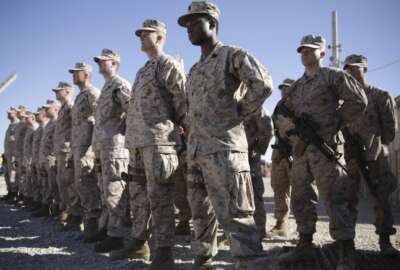The Marine Corps is the second military service that says it will be minimally affected by the Defense Department’s new non-deployable strategy.
Gen. Glenn Walters, the Marine Corps assistant commandant, said less than 0.5 percent of the Marine total force is “truly non-deployable.”
“About 1,000 [nondeployable Marines], that’s about what we’ve been seeing for a long time. When do I get worried about it? As soon as non-deployable status in the Marine Corps affects our ability to meet our staffing goals both on the supporting establishment side and the operational side,” Walters said, during a March 6 speech at the McAleese/Credit Suisse Defense Programs Conference in Washington.
The Marine Corps currently has an end strength of 186,000, that number is expected to only increase slightly by about 400 in the next year.
Walters said the Marines need to keep their foot on the gas with recruiting to stay at that level.
While the Marine Corps has less than a half a percent that are truly non-deployable, it doesn’t mean that there aren’t more Marines that fit the nondeployable category. Walters said many of the Marines that fit the criteria of non-deployable need to catch up on things as simple as getting their teeth checked.
DoD announced its policy last month to begin separating troops that have been nondeployable for more than a year.
Currently, the military has more than a quarter of a million non-deployable troops.
Air Force Secretary Heather Wilson said last month her service isn’t sweating the new policy either.
“The Air Force has had a lower percentage of non-deployable people than the other services historically. We also have some career fields that don’t deploy at all,” Wilson said. “I would expect we would try to implement [the DoD] policy with two priorities in mind. One is the lethality and readiness of the force overall to be able to fight. The second is fairness. There is an argument that says if you have 100 people that can do a job and 10 of them that are non-deployable, the other 90 are carrying the greater burden. If that’s true then we’ve got to do things that are fair.”
The Air Force is tasked with growing to 325,000 airmen, and the 2019 budget request bumps end strength up to almost 330,000.
That comes as the military is already competing with private industry for talented individuals and the pool from which the military can take employees is small. The Pentagon estimates only about 25 percent of people between 17 and 34 are eligible to serve.
Wilson and Lt. Gen. Steven Kwast, the commander of Air Education and Training Command, did not seem worried about finding the people to fill the spots.
“We have a fairly small number of people who are not deployable. We are pulling numbers now. You have to be non-deployable for over 12 months and they accept wounded warriors and they accept those who are pregnant or postpartum. … We need to look at who is permanently non-deployable, what are their skill sets, do they even have to deploy?” Wilson said.
Kwast, who is in charge of recruitment, seemed optimistic about the Air Force’s ability to handle the challenge.
“If we have a nice network model of being able to have insight into the talent in civil society, we can find people who have the fitness to be able to deploy and the talent to do the jobs we need done. It doesn’t have to be one or the other. It can be both, but only if we have a deep enough pool of people we can reach and deep enough pool of people we can measure the talent of and then marry it up with our needs,” Kwast said. “There are 330 million people in America.”
Copyright
© 2024 Federal News Network. All rights reserved. This website is not intended for users located within the European Economic Area.
